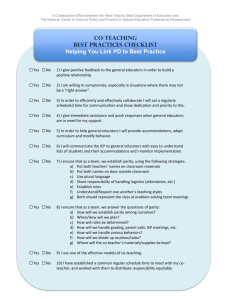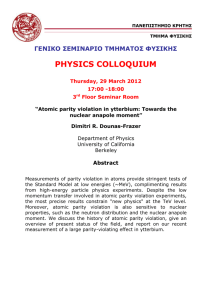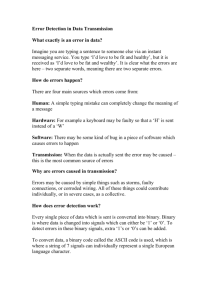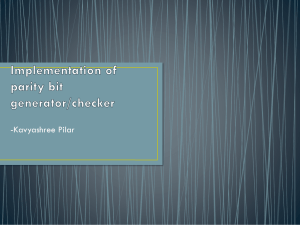World Economy
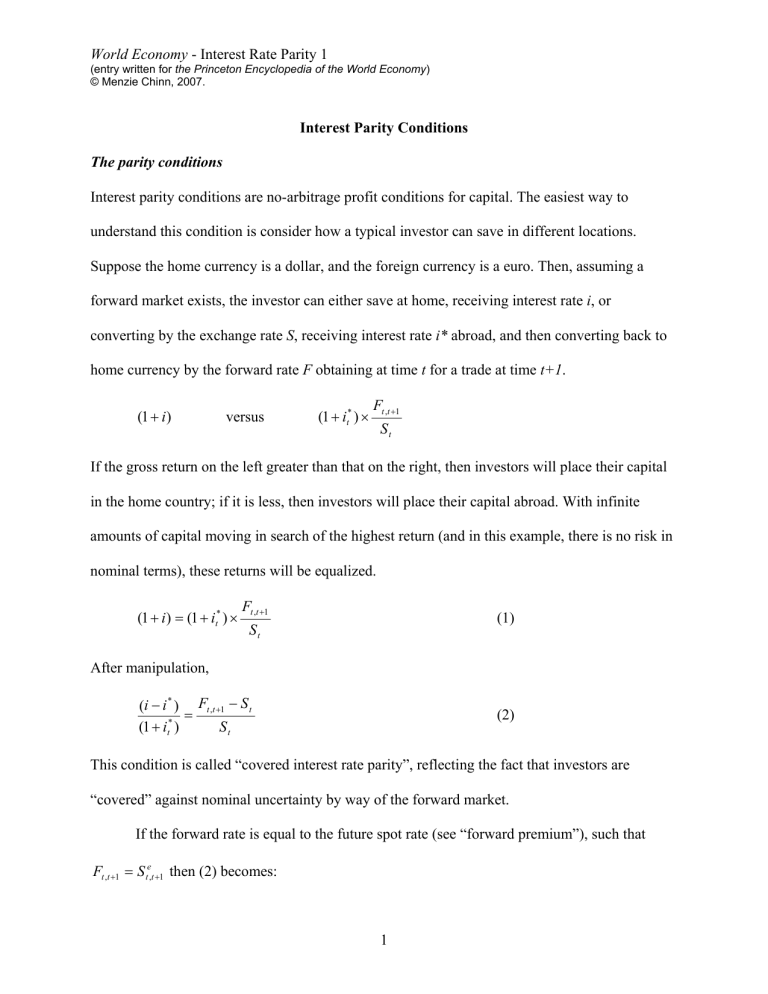
World Economy - Interest Rate Parity 1
(entry written for the Princeton Encyclopedia of the World Economy )
© Menzie Chinn, 2007.
Interest Parity Conditions
The parity conditions
Interest parity conditions are no-arbitrage profit conditions for capital. The easiest way to understand this condition is consider how a typical investor can save in different locations.
Suppose the home currency is a dollar, and the foreign currency is a euro. Then, assuming a forward market exists, the investor can either save at home, receiving interest rate i , or converting by the exchange rate S , receiving interest rate i* abroad, and then converting back to home currency by the forward rate F obtaining at time t for a trade at time t+1 .
( 1
+ i ) versus
( 1
+ i )
=
( 1
+ i t
*
)
×
F t , t
+
1
S t
( 1
+ i t
*
)
×
F t , t
+
1
S t
If the gross return on the left greater than that on the right, then investors will place their capital in the home country; if it is less, then investors will place their capital abroad. With infinite amounts of capital moving in search of the highest return (and in this example, there is no risk in nominal terms), these returns will be equalized.
(1)
After manipulation,
( i
− i
*
)
( 1
+ i t
*
)
=
F t , t
+
1
−
S t
S t
(2)
This condition is called “covered interest rate parity”, reflecting the fact that investors are
“covered” against nominal uncertainty by way of the forward market.
If the forward rate is equal to the future spot rate (see “forward premium”), such that
F t , t
+
1
=
S e t , t
+
1
then (2) becomes:
1
World Economy - Interest Rate Parity 2
(entry written for the Princeton Encyclopedia of the World Economy )
© Menzie Chinn, 2007.
( i
−
( 1
+ i i
* t
*
)
)
=
S e t , t
+
1
−
S t
S t
(3)
Where the e superscript denotes “expected”. Equation (3) is termed “uncovered interest rate parity”. This expression holds when investors do not require compensation for the uncertainty associated with trading currencies in the future. It states that expected nominal returns are equalized across borders in common currency terms.
When interest rates are low, the following log approximations are often used for equations (2) and (3).
( i t
− i t
* )
= f t , t
+
1
− s t
( i t
− i t
*
)
= s e t , t
+
1
− s t
(2’)
(3’)
Frankel (1991) has labeled condition (2) holding as characterizing perfect capital mobility, while condition (3) is associated with perfect capital substitutability. These terms arise from the view that if (2) does not hold, there must be some sort of impediment – capital controls or the threat thereof – to the free flow of financial capital. But even if capital is free to move, investors may still respond to risk; that response to risk might drive a wedge between the expected spot and forward rate. When investors are risk-neutral in nominal terms, then investors will treat capital
(say debt instruments issued in different currencies) as perfectly substitutable.
The above conditions pertain to financial capital. In order to consider the mobility of physical capital, one has to bring into play the prices of commodities. Integration of goods markets are often defined as relative purchasing power parity holding. Ex ante relative PPP can be written as: s e t , t
+
1
− s t
=
( e p t , t
+
1
− p t
)
−
( p t
*
, e t
+
1
− p t
*
) (4)
2
World Economy - Interest Rate Parity 3
(entry written for the Princeton Encyclopedia of the World Economy )
© Menzie Chinn, 2007.
Where p is the log price level. Equation 4 states that expected depreciation equals the expected inflation differential. Combining (4) with the uncovered interest rate parity condition (3’) leads to real interest parity. i t
−
( p t e
, t
+
1
− p t
)
= i t
* −
( p t
*
, t e
+
1
− p t
*
) (5)
This says the expected rate of return on capital, expressed in physical units, is equalized across borders. To the extent that in neoclassical models the marginal product of capital equals the real interest rate, this condition is equivalent to the equalization of marginal products of capital equalized across borders.
Covered Interest Parity Assessed
For developed economies since the dismantling of capital controls, covered interest parity holds fairly well. It should be noted that most tests are conducted using offshore rates, in which case
(2) is sometimes termed “closed interest parity”, although covered interest parity is often used as a term encompassing this concept.
Early tests were conducted by Frenkel and Levich (1975). They found that, after accounting for transactions costs, covered interest parity held for 3 month horizons. Offshore rates sometimes diverge from onshore rates, so that the findings of covered interest parity are somewhat weaker.
The question of whether covered interest parity holds for longer horizons is an open one.
Popper (1993) concludes that covered interest differentials at long maturities are not appreciably greater than those for short (up to one year) maturities. This is a surprising result given that there are likely a number of regulatory impediments that would tend to introduce frictions into the arbitrage process. Data from long-date currency swaps confirm this finding.
3
World Economy - Interest Rate Parity 4
(entry written for the Princeton Encyclopedia of the World Economy )
© Menzie Chinn, 2007.
Prior to the dismantling of capital controls, and in many emerging markets today, covered interest parity is unlikely to hold. In other words, covered interest differentials could be interpreted as political risk, associated with the possibility of governmental authorities placing restrictions on deposits located in different jurisdictions (clearly this is something that is not relevant when all the deposits are offshore). Aliber (1973) is credited with this interpretation, while Dooley and Isard (1980) provided empirical estimates for the DM/dollar rate.
The Empirical Evidence for Uncovered Interest Parity
Uncovered interest parity is a more difficult condition to test, essentially because expected exchange rate changes are unobservable. In the literature, most tests of UIP are actually joint tests of UIP and the rational expectations hypothesis, i.e., that ex post realizations of the exchange rate are a unbiased measure of the ex ante exchange rate, viz., s t e
, t
+
1
=
E ( s t
+
1
| I t
) . This assumption combined with equation (2’) yields this standard regression equation (sometimes called the “Fama equation”): s t
+
1
− s
= β
0
+ β
1
( f t , t
+
1
− s t
)
+ υ t
+
1
(6)
Or by virtue of covered interest parity holding, s t
+
1
− s
= β
0
+ β
1
( i t
− i t
*
)
+ υ t
+
1
(7)
Where under the joint null hypothesis
υ t
+
1
is a mean zero error unpredictable using past information, and
β
1
=
1 .
The evidence in favor of this joint hypothesis of UIP and rational expectations is quite weak. The regression of the ex post change of the spot exchange rate on either the forward discount (in equation 6), or the interest differential (in equation 7) typically yields a slope
4
World Economy - Interest Rate Parity 5
(entry written for the Princeton Encyclopedia of the World Economy )
© Menzie Chinn, 2007. coefficient estimate that is not only different from unity, but in fact negative and different from zero at conventional levels of statistical significance. This is true for reserve currencies (the U.S. dollar, the yen, the Swiss franc, the deutschemark, the franc, or their successor currency, the euro) at horizons up to a year. It is also true for some emerging market currencies (see Frankel and Poonawala, 2006). One interesting characteristic of these regressions is that, although the coefficients are typically different from zero in a statistical sense, the proportion of total variation explained is typically very small; it is not rare to obtain negative adjusted R-squared’s.
At longer horizons, (3, 5, 10 years) the evidence is more supportive of the combined UIPrational expectations hypothesis. Chinn and Meredith (2004) document that estimates of the
β
1 coefficient are usually not significantly different from the posited value of unity at 5 and 10 year horizons. The panel regression coefficient at different horizons in these regressions is depicted in
Figure 1.
1.2
0.8
/
Unbiasedness coefficient value
0.4
0.67
0.68
0.09
0.0
-0.4
-0.8
-0.54
-0.76
-0.76
3 mos. 6 mos . 1 year 3 years 5 years 10 years
Figure 1: Panel beta coefficients at different horizons.
Notes: Up to 12 months, panel estimates for 6 currencies against US$, eurodeposit rates, 1980q1-00q4;
3 year results are zero coupon yields, 76q1-99q2; 5 and 10 years, constant yields to maturity, 80q1-00q4 and 83q1-00q4. Source: Chinn (2006).
5
World Economy - Interest Rate Parity 6
(entry written for the Princeton Encyclopedia of the World Economy )
© Menzie Chinn, 2007.
The finding that the joint hypothesis of uncovered interest parity and rational expectations holds better at long horizons than at short appears to be robust. Nonetheless, some caution is necessary here. Consider regressions involving ten year interest differentials; by 2003, there would only be three non-overlapping observations available per currency. Interestingly,
Chaboud et al. (2005) find that UIP also holds at extremely short horizons of a few minutes.
Other interesting results pertain to periods of extreme market turmoil. Flood and Rose
(2002), following their 1996 work, find that uncovered interest parity holds better in recent times when the sample encompasses successful attacks on currency pegs. Nonetheless, the still find lots of heterogeneity in experiences with UIP.
A different perspective on uncovered interest parity is provided by dropping the rational expectations hypothesis. Froot and Frankel (1989) rely upon survey-based measures of exchange rates to calculate expected depreciation. They find that for reserve currencies (against the U.S. dollar) it is much more difficult to reject the null hypothesis that
β
1
=
1 . Using a broader set of currencies over a different sample period, Frankel and Chinn (1993) find that while the estimates of the slope coefficient are always greater than zero, the null of a unit coefficient is rejected in one instance. Hence, for a wider set of currencies – including some emerging market currencies
– the uncovered interest parity hypothesis does seem to carry less weight.
A new area of research involves investigation of whether uncovered interest parity holds for emerging markets. Bansal and Dahlquist (2000) found that there was a basic asymmetry in whether UIP holds. In particular, they find that when the U.S. interest rate is lower than foreign country rates, UIP holds, while UIP fails to hold when the U.S. rate is higher. They also find that idiosyncratic factors, such as the GDP per capita of the foreign country, are important in determining the degree of failure of UIP to hold.
6
World Economy - Interest Rate Parity 7
(entry written for the Princeton Encyclopedia of the World Economy )
© Menzie Chinn, 2007.
Using the forward discount in the stead of interest differentials, Frankel and Poonawala
(2006) find that there is substantial heterogeneity in the results. What matters importantly is the exchange rate regime; highly managed exchange rate regimes are associated with currencies that exhibit greater deviations from UIP.
Real Interest Parity Measured
If uncovered interest parity does not seem to hold at short horizons, it seems unlikely that real interest parity, described as exact equalization of real interest rates, would hold. However, one could still test the weaker condition that movements in real rates in one country would be met by one for one real movements in other countries.
The key difficulty with testing this condition, like that of uncovered interest parity, is that market expectations are not directly observable. Hence, one can conduct only joint tests for real interest parity. In Fujii and Chinn (2001), ex post realizations of inflation, and ex ante measures computed using recursive time series models, are used to calculate real interest rates. They find that there real interest parity holds with different strength at different horizons. As in numerous previous studies (Cumby and Obstfeld, 1984; Mark, 1985), the real interest parity (RIP) hypothesis is decisively rejected with short horizon data. At five to ten-year horizons, however, the empirical evidence becomes far more supportive and in some cases the RIP hypothesis is not rejected. In general, RIP, up to a constant , holds better at long horizons than at short. These results are robust to alternative ways of modeling expected inflation rates.
In recent years, several countries have begun issuing inflation-indexed debt securities.
Hence, one can obtain “real” real interest rates for a select number of countries, including the
U.S., the U.K., Canada and France. A cursory investigation reveals that there is no evidence of
7
World Economy - Interest Rate Parity 8
(entry written for the Princeton Encyclopedia of the World Economy )
© Menzie Chinn, 2007. equalization. Moreover, while there is some covariation, it is not anywhere near one for one.
However, the thinness of the markets and the differences in the maturities of the relevant debt instruments makes strong conclusions in either direction difficult.
Menzie D. Chinn (1/2/07)
Professor of Public Affairs and Economics
University of Wisconsin
References
Aliber, R.Z., 1973, “The Interest Parity Theorem: A Reinterpretation,” Journal of Political
Economy 81: 1451-1459.
Bansal, R. and M. Dahlquist, 2000, ‘The forward premium puzzle: different tales from developed and emerging economies,’ Journal of International Economics, Volume 51 : 115-144.
Chaboud, A.P. and J. H. Wright, 2005, “Uncovered Interest Parity: It Works, But Not For Long,”
Journal of International Economics 66(2): Pages 349-362.
Chinn, Menzie D., 2006, “The (Partial) Rehabilitation of Interest Rate Parity: Longer Horizons,
Alternative Expectations and Emerging Markets,” Journal of International Money and
Finance 25(1) (February): 7-21.
Chinn, Menzie D. and Guy Meredith, 2004, “Monetary Policy and Long Horizon Uncovered
Interest Parity,” IMF Staff Papers 51 (3) (November): 409-430.
Cumby, Robert E. and M. Obstfeld (1984) “International Interest Rate and Price Level Linkages under Flexible Exchange Rates: A Review of Recent Evidence,” in J. F. O. Bilson and
R. C. Marston (editors) Exchange rate Theory and Practice (University of Chicago
Press, Chicago, IL).
Dooley, M.P. and P. Isard, 1980, “Capital controls, political risk, and deviations from interestrate parity,” Journal of Political Economy 88(2): 370-84.
Flood, R.P. and A.K. Rose, 1996, “Fixes: Of the Forward Discount Puzzle,” Review of
Economics and Statistics : 748-752.
8
World Economy - Interest Rate Parity 9
(entry written for the Princeton Encyclopedia of the World Economy )
© Menzie Chinn, 2007.
Flood, R.B. and A. K. Rose, 2002, “Uncovered Interest Parity in Crisis,” International Monetary
Fund Staff Papers 49 : 252-66.
Frankel, Jeffrey and Jumana Poonawala, 2006, “The Forward Market in Emerging Currencies:
Less Biased Than in Major Currencies,” NBER Working Paper No. 12496 (August).
Frenkel, J.A., and R.M. Levich, 1975, “Covered Interest Parity: Unexploited Profits ?” Journal of
Political Economy 83(2): 325-338.
Froot, K.A. and J.A. Frankel, 1989,"Forward Discount Bias: Is It an Exchange Risk Premium?"
Quarterly Journal of Economics 104 (1) (February): 139-161.
Fujii, Eiji and Menzie D. Chinn, 2001, “Fin de Siècle Real Interest Parity,” Journal of
International Financial Markets, Institutions and Money 11(3/4): 289-308.
Popper, H., 1993, “Long-Term Covered Interest Parity—Evidence From Currency Swaps,”
Journal of International Money and Finance , Vol. 12, No. 4, pp. 439-48.
9




